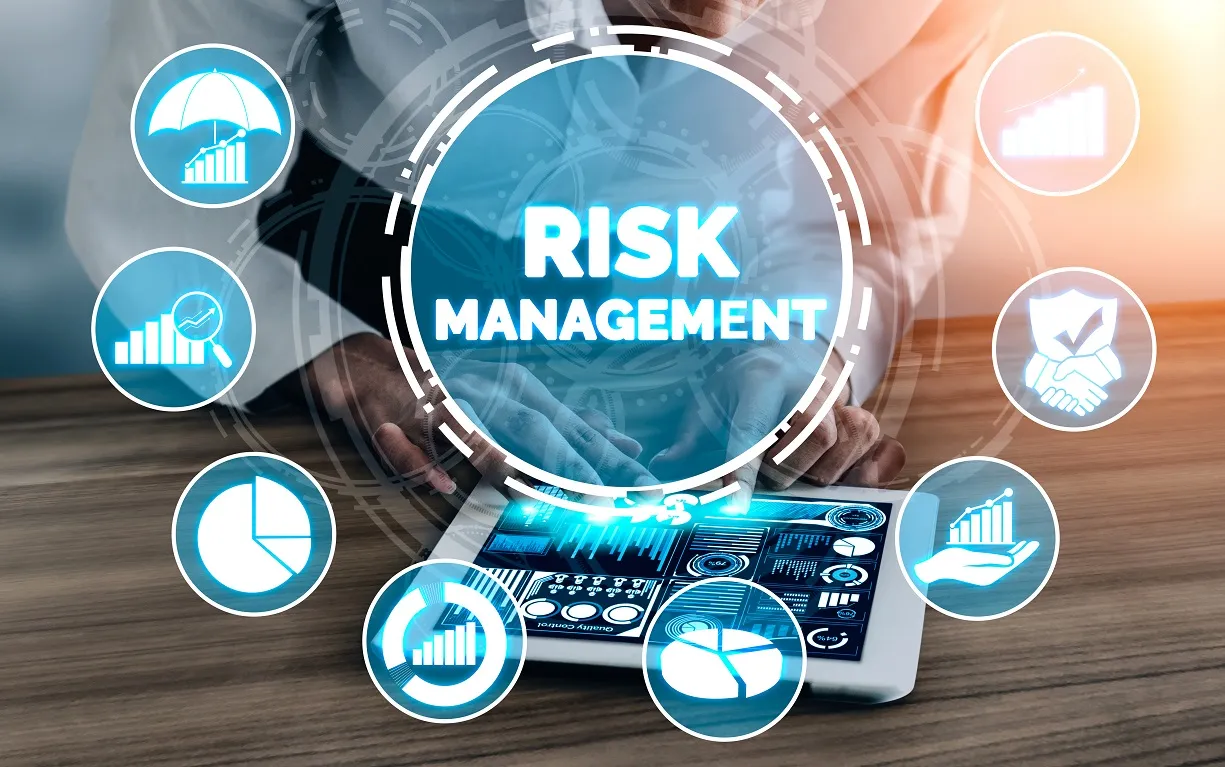In the ever-evolving world of finance, risk management has become a cornerstone for both individuals and organizations. Effective risk management strategies are essential to navigate the complexities of financial markets, regulatory requirements, and economic uncertainties. At Al Mithaq Institute, we understand the critical importance of risk management in finance, and we are committed to equipping our students with the knowledge and skills needed to excel in this field. Our comprehensive courses in financial risk management are designed to provide you with the tools to identify, assess, and mitigate risks, ensuring long-term success in your financial endeavors.
What is Risk Management in Finance?
Risk management in finance involves identifying, analyzing, and mitigating uncertainties that could negatively impact an organization's financial health. It is a proactive approach to managing potential risks that could arise from market volatility, credit issues, liquidity constraints, operational failures, and regulatory changes. The goal of risk management is to minimize the impact of these risks while maximizing opportunities for growth and profitability.
Key Components of Risk Management
- Risk Identification: The first step in risk management is identifying potential risks that could affect financial performance. This includes market risk, credit risk, liquidity risk, operational risk, and regulatory risk.
- Risk Assessment: Once risks are identified, they need to be assessed in terms of their potential impact and likelihood. This involves quantitative and qualitative analysis to prioritize risks.
- Risk Mitigation: After assessing risks, the next step is to develop strategies to mitigate them. This could involve diversifying investments, hedging, insurance, or implementing internal controls.
- Risk Monitoring: Risk management is an ongoing process. Continuous monitoring is essential to ensure that risk mitigation strategies are effective and to identify new risks as they emerge.
- Risk Reporting: Effective communication of risk management activities to stakeholders is crucial. This includes regular reporting on risk exposure, mitigation strategies, and the overall risk management framework.
Importance of Risk Management in Finance
Protecting Financial Assets
One of the primary reasons for implementing risk management in finance is to protect financial assets. By identifying and mitigating potential risks, organizations can safeguard their investments and ensure financial stability.
Enhancing Decision-Making
Risk management provides valuable insights that can enhance decision-making processes. By understanding the potential risks associated with different financial decisions, organizations can make more informed choices that align with their strategic objectives.
Regulatory Compliance
Financial institutions are subject to stringent regulatory requirements. Effective risk management ensures compliance with these regulations, reducing the risk of legal penalties and reputational damage.
Building Investor Confidence
Investors are more likely to invest in organizations that demonstrate a strong risk management framework. This builds confidence in the organization's ability to manage uncertainties and achieve long-term success.
Ensuring Business Continuity
Risk management is essential for ensuring business continuity. By identifying potential risks and developing contingency plans, organizations can minimize disruptions and maintain operations during challenging times.
Types of Financial Risks
Market Risk
Market risk, also known as systematic risk, arises from fluctuations in financial markets. This includes changes in interest rates, exchange rates, and stock prices. Market risk can impact the value of investments and the overall financial performance of an organization.
Credit Risk
Credit risk is the risk of loss due to a borrower's failure to repay a loan or meet contractual obligations. This is a significant concern for financial institutions that lend money to individuals and businesses.
Liquidity Risk
Liquidity risk refers to the risk of not being able to meet short-term financial obligations due to the inability to convert assets into cash quickly. This can lead to financial distress and even bankruptcy.
Operational Risk
Operational risk arises from internal processes, people, and systems. This includes risks related to fraud, system failures, and human error. Effective risk management strategies are essential to mitigate operational risks.
Regulatory Risk
Regulatory risk is the risk of changes in laws and regulations that could impact an organization's financial performance. This includes changes in tax laws, financial reporting requirements, and industry-specific regulations.
Risk Management Strategies
Diversification
Diversification is a key strategy for managing market risk. By spreading investments across different asset classes, sectors, and geographic regions, organizations can reduce the impact of market fluctuations on their overall portfolio.
Hedging
Hedging involves using financial instruments such as options, futures, and swaps to offset potential losses. This strategy is commonly used to manage market risk, particularly in volatile markets.
Insurance
Insurance is a risk transfer strategy that involves transferring the risk of loss to an insurance company. This is commonly used to manage risks related to property damage, liability, and business interruption.
Internal Controls
Implementing robust internal controls is essential for managing operational risk. This includes policies and procedures for fraud prevention, system security, and employee training.
Stress Testing
Stress testing involves simulating adverse scenarios to assess the potential impact on financial performance. This helps organizations identify vulnerabilities and develop contingency plans.
Scenario Analysis
Scenario analysis involves evaluating the potential impact of different scenarios on financial performance. This helps organizations understand the range of possible outcomes and make informed decisions.
Risk Management Frameworks
COSO ERM Framework
The Committee of Sponsoring Organizations of the Treadway Commission (COSO) Enterprise Risk Management (ERM) framework is a widely recognized framework for managing risk. It provides a comprehensive approach to identifying, assessing, and managing risks across an organization.
ISO 31000
The International Organization for Standardization (ISO) 31000 is a global standard for risk management. It provides guidelines and principles for managing risk in a structured and systematic manner.
Basel III
Basel III is a set of international banking regulations developed by the Basel Committee on Banking Supervision. It focuses on strengthening bank capital requirements, improving risk management, and enhancing liquidity.
Role of Technology in Risk Management
Risk Management Software
Risk management software is essential for automating and streamlining risk management processes. These tools provide real-time data analysis, risk assessment, and reporting capabilities, enabling organizations to make informed decisions.
Artificial Intelligence and Machine Learning
Artificial intelligence (AI) and machine learning (ML) are transforming risk management. These technologies enable organizations to analyze vast amounts of data, identify patterns, and predict potential risks with greater accuracy.
Blockchain Technology
Blockchain technology is being used to enhance transparency and security in financial transactions. It provides a decentralized and immutable ledger that can be used to track and verify transactions, reducing the risk of fraud and errors.
Benefits of Enrolling in Al Mithaq Institute's Risk Management Courses
Comprehensive Curriculum
Our risk management courses cover a wide range of topics, including financial risk assessment, risk mitigation strategies, regulatory compliance, and the use of technology in risk management. Our curriculum is designed to provide you with a deep understanding of risk management principles and practices.
Experienced Faculty
Our faculty members bring over a decade of professional experience in finance and risk management. They combine academic excellence with practical knowledge, providing you with valuable insights and real-world examples.
Flexible Learning Options
We offer both online and in-person courses, allowing you to choose the learning format that best suits your needs. Our flexible learning options ensure that you can balance your education with other commitments.
Accreditation and Recognition
Our certificates are recognized locally and internationally, enhancing the credibility and value of your education. Our partnership with Leeds International College, UK, ensures that our programs meet global standards.
Career Opportunities
A strong understanding of risk management is essential for a successful career in finance. Our courses prepare you for a wide range of career opportunities, including risk management analyst, financial consultant, compliance officer, and more.
Conclusion
Risk management in finance is a critical skill for navigating the complexities of today's financial markets. At Al Mithaq Institute, we are committed to providing you with the knowledge and skills needed to excel in this field. Our comprehensive courses, experienced faculty, and flexible learning options ensure that you are well-prepared to manage risks and achieve long-term success in your financial career. Enroll in our risk management courses today and take the first step towards a successful future in finance.
Why Choose Al Mithaq Institute for Your Risk Management Education?
At Al Mithaq Institute, we pride ourselves on offering a holistic educational experience that combines theoretical knowledge with practical application. Our risk management courses are designed to equip you with the skills needed to thrive in the financial industry. Here are some reasons why you should choose us:
Industry-Relevant Curriculum
Our courses are regularly updated to reflect the latest trends and developments in risk management. We ensure that our students are well-prepared to meet the challenges of the modern financial landscape.
Hands-On Learning
We believe in learning by doing. Our courses include case studies, simulations, and real-world projects that allow you to apply your knowledge in practical scenarios.
Networking Opportunities
Our students have access to a vast network of industry professionals, alumni, and faculty members. This provides valuable networking opportunities that can enhance your career prospects.
Career Support
We offer career support services, including resume building, interview preparation, and job placement assistance. Our goal is to help you achieve your career aspirations.
Global Perspective
Our courses provide a global perspective on risk management, preparing you to work in diverse and international environments.
Testimonials from Our Students
"Enrolling in the risk management course at Al Mithaq Institute was one of the best decisions I made. The comprehensive curriculum and experienced faculty provided me with the knowledge and skills needed to excel in my career. I highly recommend this institute to anyone looking to advance in the field of finance."
- Ahmed Al Mansoori, Risk Management Analyst
"The flexible learning options at Al Mithaq Institute allowed me to balance my studies with my professional commitments. The hands-on learning approach and real-world projects were particularly valuable in preparing me for the challenges of the financial industry."
- Fatima Al Hashimi, Financial Consultant
Frequently Asked Questions (FAQs)
1. What are the prerequisites for enrolling in the risk management courses?
Our risk management courses are designed for individuals with a background in finance, accounting, or business. However, we also welcome students from other disciplines who are interested in pursuing a career in risk management.
2. Are the courses available online?
Yes, we offer both online and in-person courses to accommodate the needs of our students. Our online courses provide the same high-quality education as our in-person programs.
3. How long does it take to complete a risk management course?
The duration of our risk management courses varies depending on the program. Most courses can be completed within 6 to 12 months.
4. What career opportunities are available after completing the course?
Graduates of our risk management courses can pursue a wide range of career opportunities, including risk management analyst, financial consultant, compliance officer, and more.
5. Is financial aid available?
Yes, we offer financial aid and scholarships to eligible students. Please contact our admissions office for more information.
Enroll Today and Take Control of Your Financial Future
Risk management is a critical skill for anyone looking to succeed in the financial industry. At Al Mithaq Institute, we are committed to providing you with the education and support needed to achieve your career goals. Enroll in our risk management courses today and take the first step towards a successful future in finance.
Explore Our CoursesAdditional Resources
Blog: Visit our blog for the latest insights and trends in risk management and finance. Read More
Courses: Explore our comprehensive range of courses in risk management and other financial disciplines. View Courses
Contact Us: Have questions? Our team is here to help. Get in Touch







